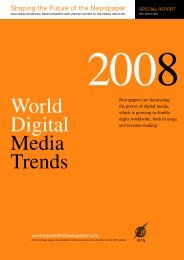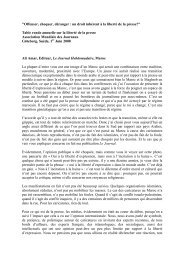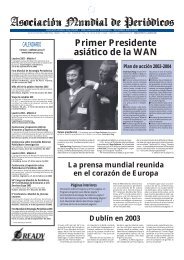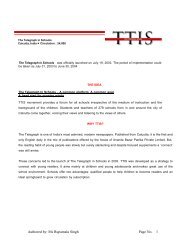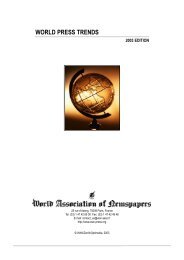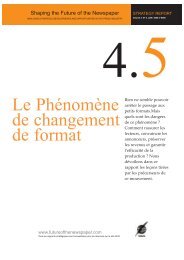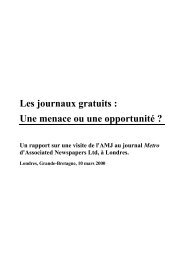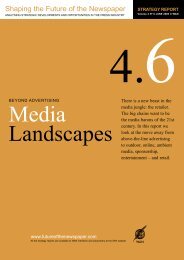was distributed free in the city’s air-conditioned buses for the first few months <strong>of</strong> its launch.And, <strong>of</strong> course, you can pick up some <strong>of</strong> the major dailies for free at domestic airports. A fewyears ago, even Mid-day had tried its luck with a free daily, when it launched a communitynewspaper, Metro, which were distributed free in different localities in Mumbai with aseparate edition for each place. This was launched with an aim to bring in small timeadvertisers, who couldn’t make it to the main edition. But leaving aside these few instancesand the fistful <strong>of</strong> small-time local players such as ‘Neighbourhood Flash’ and ‘OntrackSuburb’, India is still to get a full-fledged free daily. Estimates suggest that there are around25 million copies <strong>of</strong> free dailies being distributed around the world. The lack <strong>of</strong> freenewspapers is especially surprising when you consider that Indian newspapers are thecheapest in the world – cheaper by far than any newspaper in the developed world or evendeveloping countries like Pakistan. In fact, many English dailies are sold for as low as Re 1 orRs 2 – practically free, you could say. The initial subscription <strong>of</strong>fers <strong>of</strong> ‘DNA’ and‘Hindustan Times’ (‘HT’) in Mumbai, during their launch period, further reduced the cost <strong>of</strong>the newspaper to around 50 paise for an average issue. When Indian newspaper publishers are<strong>of</strong>fering their dailies dirt cheap, why is that till date, we haven’t got a full-fledged free daily?According to Lynn D’Souza, director, Lintas Media Group, the current model <strong>of</strong> low-priceddailies is a result <strong>of</strong> competitive pressures, rather than a deliberate attempt to develop a uniquebusiness model. D’Souza says, “The model in India is to charge a low subscription cost and totie up with advertisers for good consumer promotions, plus to <strong>of</strong>fer huge incentives to thetrade.” She points out that the free dailies that exist abroad genuinely operate on a differentbusiness model, from the type <strong>of</strong> editorial they cover to the costs they incur on reportage, etc.Indian media experts are unanimous in the belief that the quality <strong>of</strong> newsprint and theeditorial content <strong>of</strong> the free dailies in Europe and North America are poor in quality, whichmight not be acceptable to either Indian readers or advertisers. Other senior media plannerssuch as Ravi Kiran, CEO, South Asia, Starcom MediaVest Group, are <strong>of</strong> the opinion that themindset <strong>of</strong> Indian advertisers and media planners work against free vehicles when it comes tonewspapers and magazines. Kiran cites the example <strong>of</strong> magazines such as ‘Filmfare’, whichhave been badmouthed by the industry in the past because they <strong>of</strong>fered a premium the value<strong>of</strong> which compared with the cover price <strong>of</strong> the magazine. “This mindset is really sad sincethey do not apply the same logic to free to air TV or radio!” exclaims Kiran. It is said that freedailies do well in markets where the cost <strong>of</strong> a newspaper is at par or more than a can <strong>of</strong> s<strong>of</strong>tdrink. It also works in markets where the retail and classified sectors are well developed. NDBadrinath, director, client services, AC Nielsen, which is into media research, concurs withthe same. He says, “The ratio <strong>of</strong> advertising and subscription revenue for an Indian newspaperpublisher is 80:20. And this 20 per cent subscription revenue needs to be compensated byadvertising revenue, which can come from a rise in classified advertising.” But he says,“Classified advertising is still to pick up in India. Indian consumers still rely more on word <strong>of</strong>mouth rather than classified advertising, unlike the trend in other developed countries.” Butdoes this mean India cannot sustain a free daily model? Bhaskar Das, executive president,‘TOI’, doesn’t see it happening in the next five years, not even in the case <strong>of</strong> ‘MumbaiMirror’, which is being distributed free now with the ‘TOI’. Das points out that it wouldn’t becorrect to slot ‘Mumbai Mirror’ as a free daily. Rather, ‘Mumbai Mirror’ complements the‘TOI’. Above all, it is also sold as a standalone newspaper at the newsstands. The biggesthindrance for a ‘free’ business model, according to Das, is the existence <strong>of</strong> the ‘raddi’ (scrap)market. He explains, “Unlike other developed countries, there is a value for ‘raddi’ in India.Keeping copies <strong>of</strong> free dailies at pick-up terminals such as a railway station or a bus terminuswill not ensure that the dailies reach the readers. And having our own distribution network toensure that the dailies reach the readers’ homes is not financially viable.” “This in turn makesit difficult to identify the readers <strong>of</strong> a free daily, which will again create the wrong illusion for36
advertisers. That’s why such a business model has a huge logistical problem in India.” Dasadds, “By distributing the ‘Mumbai Mirror’ free along with the ‘TOI’, we can at least ensurethat the daily is reaching the existing ‘TOI’ readers.” “It’s a strategic decision,” he quips.But not everyone is so pessimistic, at least not those on the advertising front. Kiran <strong>of</strong>Starcom is hopeful that there is a potential for free newspapers in India. “As the establishednewspapers stagnate or shrink in their readership, and as key audience segments such as theyouth are lost to other media, newspaper publishers will be forced to launch free titles toappeal to the non-readers <strong>of</strong> traditional dailies.” According to him, there is a lack <strong>of</strong> properfuture focus among publishers. Currently, many publishers are boosting their revenue bylaunching additional editions and increasing their ad rates periodically. But very soon, asKiran <strong>of</strong> Starcom, says, these two initiatives will stop working. D’Souza <strong>of</strong> Lintas is positivethat India could have some free dailies a few years from now, especially in the metros andmini metros. She is <strong>of</strong> the opinion that the growth <strong>of</strong> the retail sector will drive the growth infree dailies in India. She says, “These free dailies will be supported by these growing number<strong>of</strong> shopping malls both in terms <strong>of</strong> advertising revenue and solving the logistical problem <strong>of</strong>being a distribution centre <strong>of</strong> free dailies as opposed to the current news agent system.”http://www.agencyfaqs.com/news/stories/2006/05/29/15136.html; May 29, 2006IrelandThe Irish Daily Mail was launched nationwide on February 6, 2006. The paper is being givenaway free on its first day as a promotional measure, and will cost 30 cent for the rest <strong>of</strong> thisweek. Executive Editor Paul Drury, speaking on RTÉ Radio, would not say what the paperwould cost after that but said it would be 'aggressively priced'. The publication describes itselfas a modern newspaper for a modern Ireland and will have an initial print run <strong>of</strong> 200,000copies. This is the latest in a run <strong>of</strong> investments into the Irish market by Associated<strong>Newspapers</strong>. The British newspaper group already publishes Ireland on Sunday and, inOctober last year, it launched a Dublin edition <strong>of</strong> its commuter freesheet, Metro.http://www.rte.ie/news/2006/0206/dailymail.html; February 6, 2006LithuaniaNordic publishing house Schibsted ASA (Nachrichten) has bought a 99.99 pct stake in thefree Lithuanian daily paper 15min for an undisclosed sum, the BNS news service reported.'High ambitions for growth in the Lithuanian market and Schibsted's experience make theacquisition <strong>of</strong> 15min a natural step for our company,' Schibsted Baltics CEO Mart Kadastiksaid in a statement. Launched on Sept 1 last year, 15min is published five days a week and isdistributed in Vilnius and the second-biggest city <strong>of</strong> Kaunas. The newspaper has a circulation<strong>of</strong> 85,000. In Lithuania, Schibsted already holds a 67 pct stake in the magazine publishinggroup Zurnalu Leidybine Grupe, and a 51 pct stake in the LT newspaper.http://www.finanznachrichten.de/nachrichten-2006-03/artikel-6215918.asp; March 30, 2006LithuaniaLithuanian free daily 15min will launch editions in second city Kaunas (circulation 35,000)on February 1 and in third city Klaipeda (circ. 25,000) in March. The new editions will havesome specific local content. Total circulation <strong>of</strong> 15min will be 110,000 after both launches.FDN Newsletter No. 14, February 2006MexicoMetro International SA will start a new edition <strong>of</strong> its free Metro newspaper in Mexico Citythrough a joint venture with two local partners. Metro and Mxshares SA de C.V. will have a37
- Page 1 and 2: SFN Flash March-June 2006Monthly up
- Page 3 and 4: Qassim, General Manager of the news
- Page 5 and 6: Schibsted, which owns the largest n
- Page 7 and 8: http://www.brandrepublic.com/bullet
- Page 9 and 10: for mobile content, putting us in t
- Page 11 and 12: 14.9 percent. Ad sales at the unit
- Page 13 and 14: shares, particularly because we con
- Page 15 and 16: FranceAxel Springer said it is mull
- Page 17 and 18: include both the employee’s and t
- Page 19 and 20: party's policy-making Central Stand
- Page 21 and 22: United KingdomThe Financial Times r
- Page 23 and 24: Search-engine-linked advertising co
- Page 25 and 26: GermanyHeads of Baden-Wuerttemberg
- Page 27 and 28: ZambiaThe overwhelming success of a
- Page 29 and 30: and, above all, "wanted," heralding
- Page 31 and 32: Khalifa to discuss the editorial pl
- Page 33 and 34: eaders who cannot, or are not willi
- Page 35: * * * * *Plans by Icelandic media h
- Page 39 and 40: are brands as well. They depend on
- Page 41 and 42: UkraineIn March, Dutch publisher TM
- Page 43 and 44: debate in the Forum. http://www.bra
- Page 45 and 46: eaders than traditional magazines.
- Page 47 and 48: channels (+8%) or even Internet por
- Page 49 and 50: Ilbo (21.2 percent), DongA Ilbo (19
- Page 51 and 52: status warned that they might destr
- Page 53 and 54: United Arab EmiratesIn December 200
- Page 55 and 56: last year but Fujitsu has shown a p
- Page 57 and 58: EDITORIAL CONTENTImage & Credibilit
- Page 59 and 60: http://www.redherring.com/Article.a
- Page 61 and 62: WeddingsChinaMany newly-weds in Nan
- Page 63 and 64: and editorial strategies with publi
- Page 65 and 66: Vucinic believes the fratricidal co
- Page 67 and 68: COPYRIGHTDigital Environment / Onli
- Page 69 and 70: United States of AmericaAmerican me
- Page 71 and 72: * * * * *Russia's state-run energy
- Page 73 and 74: newspaper business. http://www.them
- Page 75 and 76: Fair CompetitionKorea, Republic ofT





